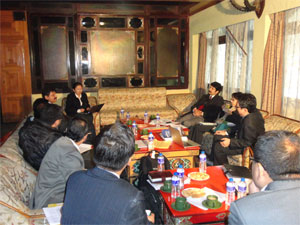Project Objective

To strengthen biodiversity conservation activities and forest management capacity, and to improve livelihood for the local people who are dependent on forests by promoting sustainable biodiversity conservation, afforestation and income generation activities including eco-tourism for the community development, thereby contributing environment conservation and harmonized socio-economic development of Sikkim.
Necessity and Priority of the Project
Necessity of the Biodiversity Conservation in the State of Sikkim
In the State of Sikkim, more than 4,500 flowering plants are found, and among those plants in particular, there are 550 species of orchids and 36 species of rhododendron. Furthermore, in view of the global biodiversity conservation, there are more than 50 flowering plants which are considered to be in danger of extinction, and precious flowering plants are conserved in the State of Sikkim. The State of Sikkim is located in the area of the Biodiversity Hotspot of Eastern Himalaya Region, and flowering plants per unit area are abundant compared with the other neighboring states and countries such as Nepal and Bhutan. Moreover, other than flowering plants, there are many animal species living in the State of Sikkim; more than 50 kinds of fishes, 690 kinds of butterflies, 16 kinds of amphibian (one species recognized in danger of extinction), 78 kinds of reptiles, 550 kinds of birds (11 species recognized in danger of extinction), 154 mammals (12 species recognized in danger of extinction).
Necessity of the Forest Management in the State of Sikkim
The forest cover in Sikkim was 37% in 1975. However, the forest cover increased steadily, and it became 46% in 2005. However, the open forest accounts for around 25%, and forest cover in Sikkim does not satisfy the national forest cover target, which is two third of the total geographical area in the hilly states. Considering the severe natural environment of the northern part of Sikkim to grow trees, although is difficult to achieve the national target, Department of Forest, Environment, and Wildlife Management (DFEWM) considers to increase the forest cover substantially in the near future for people living in the forest fringe area who are heavily dependent on the natural forest resources such as fuel wood for the source of energy, and fodder, medicinal plants, herbs for their own consumption. Although the scale is not so clear, there seems to be illegal collection of the forest products within the public lands by the local people. Furthermore, soil moisture conservation capacity is not enough to prevent landslides which occur in many part of Sikkim.
Necessity of the Capacity Development of DFEWM in the State of Sikkim
Sikkim has rich nature as stated above, but the capacity of the DFEWM is not sufficient to effectively manage and sustain the biodiversity conservation and forests. Since the 80% of the total geographical area is under the administration of the DFEWM, capacity development as well as the development of hard infrastructure of DFEWM should be enhanced. In particular, since DFEWM has advantage in accessing the remote area, appropriate forest management involving local people participation in the remote area is needed. Moreover, scientific forest management in terms of organizational set-up and facilities such as Geographical Information System (GIS) should be enhanced for the protection of eco-system in Sikkim.
Harmonized Socio-Economic Development of the State of Sikkim
As Sikkim experiences moderate temperature in summer and has the exceptionally rich biodiversity and unique culture, there is remarkable increase in the number of tourists recently. On average of the last 10 years, domestic tourists and foreign tourists visiting Sikkim has increased by 11.2%, and 14.2% per annum respectively. The growth of the tourism contributes to the increase of the State GDP, and the overall poverty rate in the state improved significantly from 36.6% in 1999/2000 to 19.2% in 2004/2005 which is below the national poverty rate of 27.8%. However, there are several Gram Panchayat Wards identified as ?Poverty Hotspot? according to the survey conducted by Department of Rural Management and Development, and most of them could be considered dependent on the forest resources such as fuel wood. Furthermore, as promotion of the tourism could provide negative impact on the natural environment in Sikkim, appropriate measures for the protection of the natural environment should be taken up.